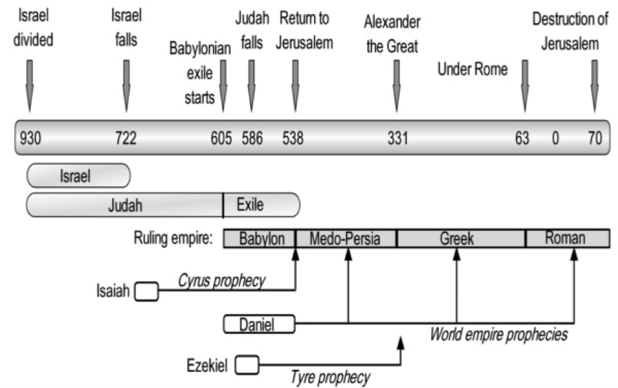Isaiah’s Prophecy about Cyrus, King of Persia
“The Lord …… who says of Cyrus, ‘He is my shepherd and will accomplish all that I please; he will say of Jerusalem, “Let it be rebuilt,” and of the temple, “Let its foundations be laid.” “This is what the Lord says to his anointed, to Cyrus, whose right hand I take hold of to subdue nations before him and to strip kings of their armor, to open doors before him so that gates will not be shut.” Isaiah 44:28-45:1
This prophecy is abundantly clear: A certain man named “Cyrus” will authorize the rebuilding of Jerusalem and the temple.
Please check the timeline (see figure below) related to this prophecy. Isaiah prophesied around 700 BC, about 100 years before Babylon destroyed Jerusalem and perhaps 160 years before Cyrus, king of Media and Persia, conquered Jerusalem and Babylon in 539 BC. The following year Cyrus permitted Jews to return to their land and build a temple:
“In the first year of Cyrus king of Persia, in order to fulfill the word of the Lord spoken by Jeremiah, the Lord moved the heart of Cyrus king of Persia to make a proclamation throughout his realm and to put it in writing: This is what Cyrus king of Persia says: ‘The Lord, the God of heaven, has given me all the kingdoms of the earth and he has appointed me to build a temple for him at Jerusalem in Judah . Anyone of his people among you—may the Lord his God be with him, and let him go up." 2 Chronicles 36:22-23 (cf. Ezra 1:1-4)
Analysis of the prophecy:
- The prophecy is crystal clear, historically fulfilled, and beyond control of the Jews.
- The archaeological discovery of the “Cyrus Cylinder” confirms Cyrus’ policies as to the freedom of religion. It explains why Cyrus let the Jewish captives return to rebuild the Jerusalem temple exactly as predicted in the prophecy.
- The weakest criterion is the dating of this prediction of Isaiah, given the Deutero-Isaiah alternative. This theory claims the latter part of the book was written later by another author. Actually, the Cyrus prophecy is probably the reason liberal critics have tried to re-date the second half of Isaiah and onwards to around 550 BC or later.
